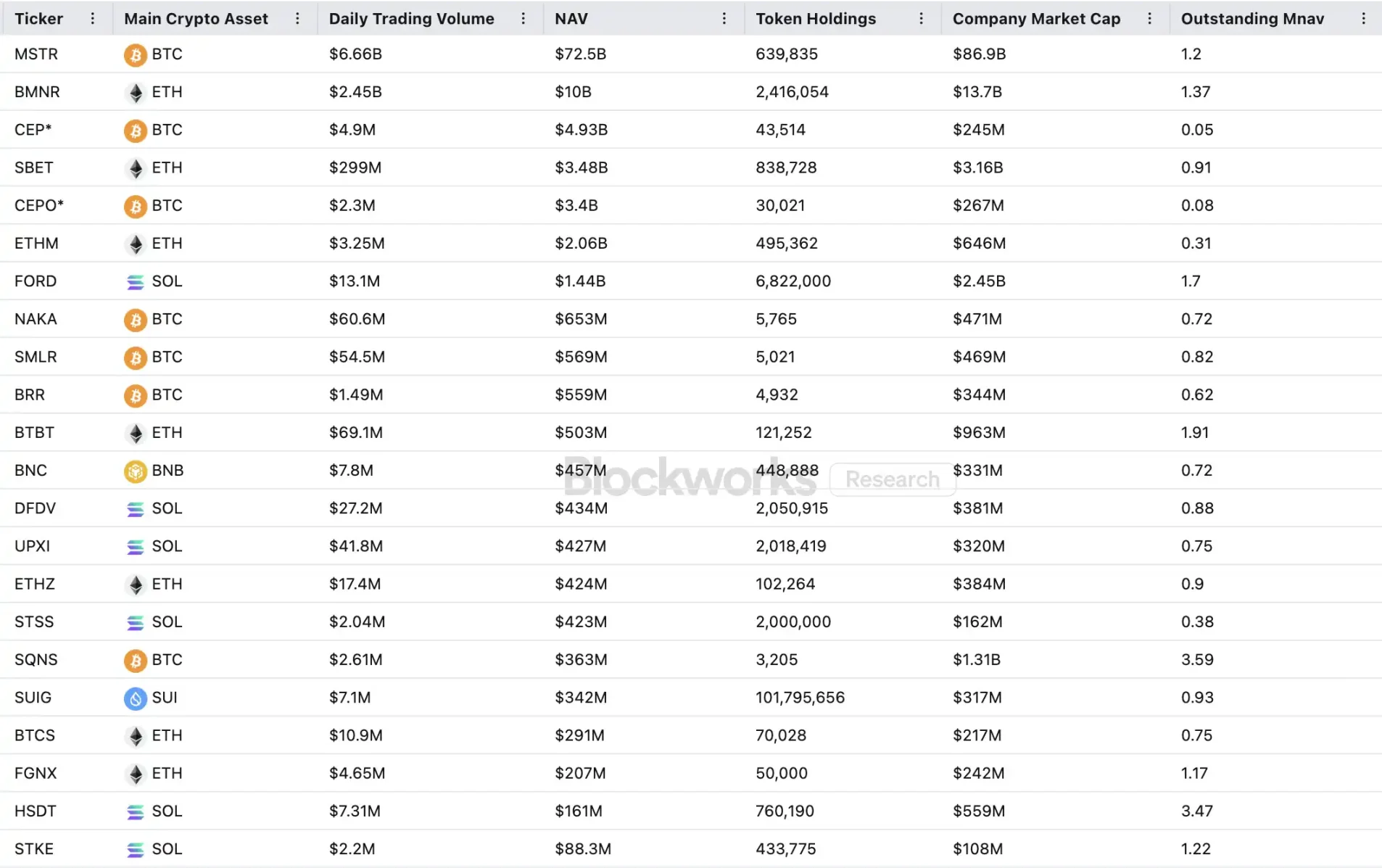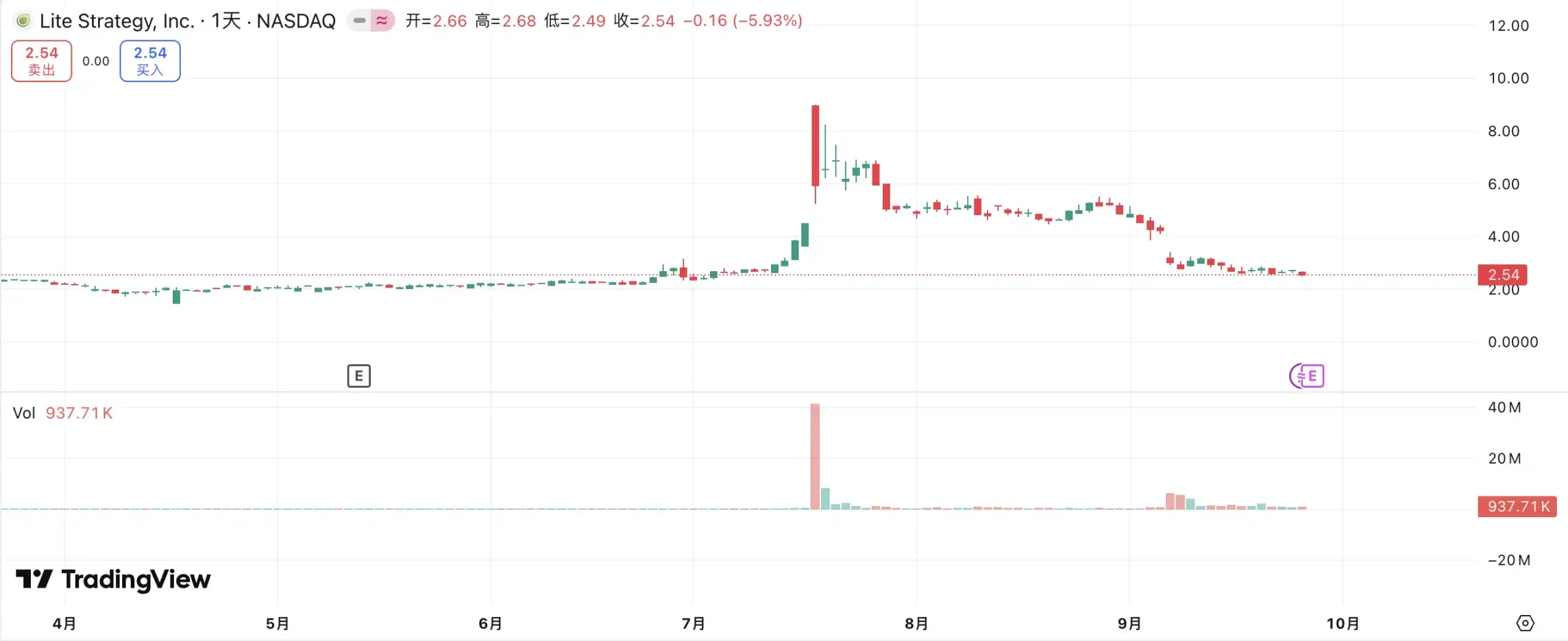What Should Investors Pay Attention to When DAT Hits the Brakes?
Written by: kkk, Rhythm
On September 24, the U.S. Securities and Exchange Commission (SEC) and the Financial Industry Regulatory Authority (FINRA) jointly announced that they would investigate over 200 publicly listed companies that had previously announced crypto treasury plans, citing "abnormal stock price fluctuations" that commonly occurred just before these companies released related news.
Since MicroStrategy first incorporated Bitcoin into its balance sheet, "Crypto Treasury" has become a sensational "financial alchemy" in the U.S. stock market—new stocks like Bitmine and SharpLink have seen their prices soar dozens of times due to similar operations. According to data released by Architect Partners, 212 new companies have announced plans to raise approximately $102 billion since 2025 to purchase mainstream crypto assets like BTC and ETH.
However, this capital frenzy has raised widespread skepticism while pushing prices higher. MSTR's mNAV (market capitalization to net asset value ratio) fell from 1.6 to 1.2 within a month, while two-thirds of the top twenty crypto treasury companies had an mNAV below 1. Questions regarding asset bubbles and insider trading have emerged, and this new asset allocation trend is facing unprecedented regulatory challenges.

How the Flywheel of Crypto Treasury Companies Operates
The financing flywheel of treasury companies is built on the mNAV mechanism, which is essentially a reflexive flywheel logic that gives treasury companies the appearance of having "unlimited bullets" during a bull market. mNAV refers to the market net asset value ratio, calculated as the company's market capitalization (P) relative to its net asset value (NAV) per share. In the context of treasury strategy companies, NAV refers to the value of the digital assets they hold.
When the stock price P is higher than the net asset value NAV (i.e., mNAV > 1), the company can continuously raise funds and reinvest the raised capital into digital assets. Each issuance and purchase will push up the per-share holdings and book value, further strengthening market confidence in the company's narrative and driving the stock price higher. Thus, a closed-loop positive feedback flywheel begins to turn: mNAV rises → financing through issuance → purchase of digital assets → per-share holdings increase → market confidence strengthens → stock price rises again. It is through this mechanism that MicroStrategy has been able to continuously finance and purchase Bitcoin over the past few years without severely diluting shares.
Once the stock price and liquidity are pushed high enough, the company can unlock a full set of institutional funding mechanisms: it can issue debt, convertible bonds, preferred stocks, and other financing tools, turning market narratives into book assets, which in turn push up the stock price, forming a flywheel. The essence of this game is the complex resonance between stock price, narrative, and capital structure.
However, mNAV is a double-edged sword. A premium can represent a high level of market trust, but it may also simply be speculative hype. Once mNAV converges to 1 or falls below 1, the market shifts from "thickening logic" to "dilution logic." If the price of the tokens themselves drops during this time, the flywheel will switch from positive to negative feedback, resulting in a double whammy of market capitalization and confidence. Additionally, the financing of treasury strategy companies is also built on the premium flywheel of mNAV; when mNAV remains at a discount for an extended period, the space for issuance will be blocked, and the business of small and mid-cap shell companies that are already stagnant or on the verge of delisting will be completely overturned, causing the established flywheel effect to collapse instantly. Theoretically, when mNAV is 1, a more reasonable choice for the company would be to sell holdings to repurchase shares to restore balance, but it should not be generalized; discounted companies may also represent undervalued assets.
During the bear market of 2022, even when MicroStrategy's mNAV briefly fell below 1, the company chose not to sell coins to repurchase shares but instead insisted on retaining all Bitcoin through debt restructuring. This "holding on" logic stems from Saylor's faith-based vision of BTC, viewing it as a core collateral asset that "will never be sold." However, this path is not replicable by all treasury companies. Most altcoin treasury stocks lack stable core businesses, and transitioning to "coin-buying companies" is merely a means of survival without the backing of faith. Once the market environment deteriorates, they are more likely to sell off to stop losses or realize profits, triggering a stampede.
Related Reading: "First Selling Coins, Delisting, Coin Stocks No Longer Being Cryptocurrency Pi Xiu"
Is Insider Trading Present?
SharpLink Gaming is one of the earliest cases that triggered market turbulence during this wave of "crypto treasury fever." On May 27, the company announced it would increase its holdings of Ethereum as reserve assets by up to $425 million, and on the day the news was released, the stock price soared to $52. However, strangely, the trading volume of the stock had already significantly increased on May 22, with the price jumping from $2.7 to $7, even though the company had not yet released any announcements or disclosed any information to the SEC.

This phenomenon of "news not released, stock price moving first" is not an isolated case. MEI Pharma announced on July 18 that it would initiate a $100 million Litecoin treasury strategy, but the stock price had already risen for four consecutive days before the announcement, climbing from $2.7 to $4.4, nearly doubling. The company did not submit any significant updates or public press releases, and its spokesperson refused to comment on the matter.

Similar situations have also occurred with companies like Mill City Ventures, Kindly MD, Empery Digital, Fundamental Global, and 180 Life Sciences Corp, all of which experienced varying degrees of abnormal trading fluctuations before announcing their crypto treasury plans. The possibility of information leaks and pre-trading has raised regulatory concerns.
Will the DAT Narrative Collapse?
Arthur Hayes, an advisor to "Solana MicroStrategy" Upexi, pointed out that crypto treasury has become a new narrative in the traditional corporate finance circle. He believes this trend will continue to evolve across multiple mainstream asset tracks. However, we must clearly see that on each chain, there can ultimately only be one or two winners.
At the same time, the head effect is accelerating. Although over 200 companies have announced crypto treasury strategies by 2025, covering multiple chains like BTC, ETH, SOL, BNB, and TRX, funds and valuations are rapidly concentrating in a very small number of companies and assets—BTC treasuries and ETH treasuries occupy a significant portion of DAT companies. In each asset category, only one or two companies can truly emerge, with MicroStrategy in the BTC track, Bitmine in the ETH track, and possibly Upexi in the SOL track, while other projects struggle to form scale competition.

As Michael Saylor has verified, there is a large amount of institutional fund managers in the market who want to gain exposure to Bitcoin risk but cannot directly buy BTC or hold ETFs—yet they can buy MSTR stock. If you can package a company holding crypto assets into their "compliance basket," these funds are willing to buy assets worth only $1 on the books for $2, $3, or even $10. This is not irrational; it is institutional arbitrage.
In the latter half of the cycle, new issuers will still emerge in the market, resorting to more aggressive corporate financial tools to pursue higher stock price elasticity. When prices decline, these practices will backfire. Arthur Hayes predicts that this cycle will see large DAT incidents similar to the FTX collapse. At that time, these companies may crash, and their stocks or bonds could experience significant discounts, causing major market turmoil.
Regulators have also noticed this structural risk. In early September, Nasdaq proposed to enhance the review of DAT companies; today, the SEC and FINRA have jointly initiated investigations into insider trading. These regulatory actions aim to compress insider spaces, raise issuance thresholds, and increase financing difficulties, thereby reducing the manipulation space for newly emerging DAT companies. For the market, this means that "pseudo-leaders" will be accelerated out, while true leading companies will continue to survive and even grow through narrative.
Conclusion
The narrative of crypto treasury remains, but the thresholds are rising, regulations are tightening, and bubbles are clearing simultaneously. For investors, it is essential to understand the logic and arbitrage paths behind the financial structure while remaining vigilant about the risk accumulation behind the narrative—this "on-chain alchemy" cannot be performed indefinitely; the winners will prevail, and the losers will exit.
免责声明:本文章仅代表作者个人观点,不代表本平台的立场和观点。本文章仅供信息分享,不构成对任何人的任何投资建议。用户与作者之间的任何争议,与本平台无关。如网页中刊载的文章或图片涉及侵权,请提供相关的权利证明和身份证明发送邮件到support@aicoin.com,本平台相关工作人员将会进行核查。




